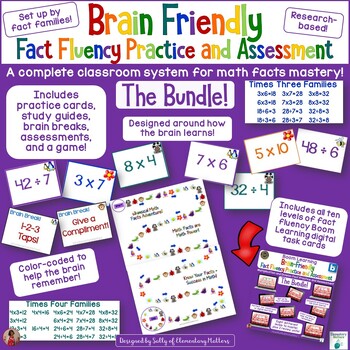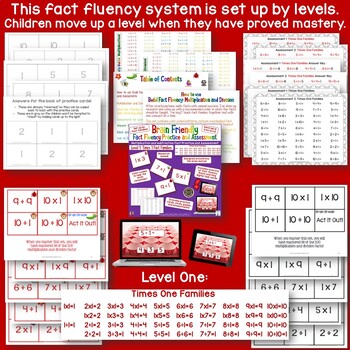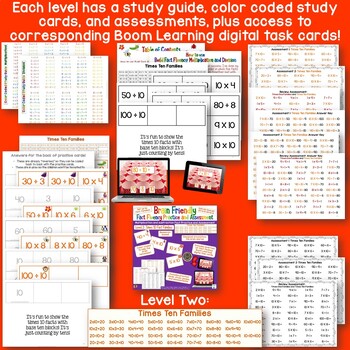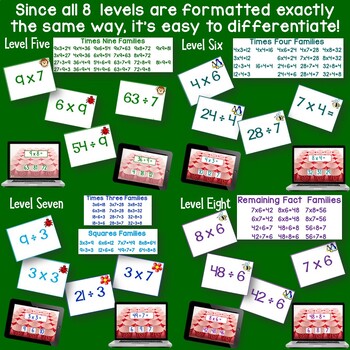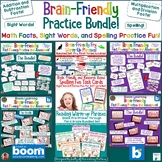Fact Fluency System for Multiplication and Division: The Bundle
- Zip
Products in this Bundle (12)
showing 1-5 of 12 products
Bonus
Also included in
- Empower your students with engaging, effective, and fun resources that focus on developing their math fact fluency, spelling words, and sight word recognition. Transform learning into an exciting adventure today! Why use Practice, Practice, Practice Bundle? Research tells us there are ways to practPrice $48.38Original Price $96.75Save $48.37
Description
This is part of a foolproof system for helping students develop fact fluency. It is research-based and developed based on how the brain learns.
This system contains research-based, brain-friendly, color-coordinated, and fact-family-coordinated practice cards and assessments for building fact fluency with multiplication and division! It also includes all ten levels of Boom Learning digital task cards!
After practicing facts with minimal success, I’ve done my research and come up with a recommended order in which the facts should be taught. The key? Teach fact families together, but with one concept at a time.
Brain Research tells us that making connections to prior knowledge helps students remember information. It also teaches us that brains remember best using color, movement, and visuals.
This set includes 10 different sets of Boom Learning digital task cards! These Boom Cards support this system for fact fluency!
This resource has everything you need to help your students master multiplication and division facts in research-based, brain-friendly ways. Plus, there are color-coded assessments for every step along the way.
This system also includes printer-friendly black and white copies. I suggest printing these on colored paper to help the brain remember the categories. Research proves the brain connects to color.
This resource also includes a number of brain breaks, which have been proven to assist the learning process.
This system suggests an order to introduce facts, color-coded fact families, fact cards, a board game for practice, Boom digital task cards for all levels, and assessments for all multiplication and division facts up through addends of ten.
I've also included several ideas for developing an understanding of multiplication and division facts, learning the facts, and assessing the facts.
You can see more about these Boom cards here:
Boom Cards are easy for the teacher and fun for the children! These can be played on computers or tablets, give immediate feedback to the children, and detailed data for the teacher.
More information about Boom cards:
"With your Teachers Pay Teachers purchase, users new to Boom Learning get a three-month free trial of student progress reporting for up to 150 students. Your trial includes the ability to make up to 5 free DIY decks. You may upgrade or cancel at any time. Boom Cards play on modern browsers (released in the last three years) on interactive whiteboards, computers, and tablets. Boom Cards apps are also available. Not sure if your browser is modern enough? Try a free Boom Cards deck first. When you redeem your purchase, Boom Learning opens an account for you if you do not already have one. If you do not subscribe at the end of your trial, you can continue using Boom Cards with the Fast Play feature. Fast Play does not track individual progress. If you do not subscribe we will delete your student records 3 months after the expiration of the trial to protect student privacy."
Be sure to download the preview file for a better understanding of what is contained in this resource. The preview includes a link to a playable preview on Boom Learning.
For other Math resources please see:
For other Math resources to promote fact fluency see:
Did you know you can earn credit that you can use for future purchases? Here’s how:
- Go to your My Purchases page. Beside each purchase, you'll see a Leave a Review button. Simply click it and you will be taken to a page where you can give a quick rating and leave a short comment on the resource.
- Each time you give feedback, TPT gives you feedback credits that you use to lower the cost of your future purchases.
- Feedback is greatly appreciated, and helps sellers create better resources!
****************************************************************************************
Be sure to click on the green ★ to follow me for updates and new product announcements!
****************************************************************************************
Designed by Sally of Elementary Matters. elementarymatters@gmail.com
♦ If you like what you see here, see my social media HERE.

